Marketing May 2, 2019
A Surprisingly Simple Way to Encourage Customers to Take a Risk
How certain kinds of visuals can inspire people to be more adventurous.

Lisa Röper
Your favorite ice-cream brand has an intriguing new flavor—but you always buy chocolate chunk. Do you take a risk and try a new treat or play it safe with the old standby?
The answer might depend on your surroundings at the grocery store—and in a way you likely wouldn’t expect.
Marketing researchers have studied many factors that affect how consumers make decisions about what to buy. But these studies typically focus on factors directly relevant to the decision at hand: people’s personality traits, for instance, or how ads frame questions. Less understood is how a person’s surroundings affect what they buy.
“In some cases, things in the environment that seem totally irrelevant to the decision—that people are seemingly unaware of—might also influence their choices,” says Ata Jami, research assistant professor of marketing at the Kellogg School.
In a new study, Jami found that viewing images that show a perspective from a high elevation, such as a mountain peak, can sway people to make riskier choices or spend more on risky products than viewing lower-perspective scenes, such as a beach. The difference arises because of the greater sense of control a higher vantage point offers, he suggests.
Since it is not necessary for customers to actually be high up—just to feel as if they are—customizing visuals in advertising could nudge shoppers to make more adventurous choices.
A Different Vantage Point
Jami’s interest in the subject was piqued by his own experience.
When touring the Empire State Building as a graduate student, he felt compelled—despite his frugal nature—to splurge at the tourist attraction’s overpriced gift store.
“I’m personally very risk-averse, so it got me thinking about how the environment can affect a person’s thinking and behavior,” he recalls.
To understand this relationship better, Jami set up a series of experiments. In each experiment, one group of participants was shown pictures from a high vantage point and another group viewed images from a lower viewpoint. Both images were of beautiful landscapes, such as mountains or meadows, to minimize chances that viewers found one scene more relaxing than the other.
In the first study, participants viewed the images and then completed an exercise designed to measure their willingness to take a risk. Specifically, they were told to inflate an animated balloon on a computer screen, earning a dollar for every 0.01 cubic feet of air they pumped, but losing everything if the balloon burst.
“Even a store at street level can use panoramic images to alter shoppers’ experience.”
On average, the group that viewed a high-elevation image pumped more air into their balloons—and thus took a greater risk that the balloon would burst.
In a second, similar experiment, the group that saw a high-elevation image was more likely than the other group to purchase new and unusual products, such as a self-stirring mug or heated butter knives.
A third study found that those who had seen the high-elevation scene were likelier to accept more risk when purchasing insurance plans. The results are not necessarily intuitive, Jami says. In fact, he could imagine that a sense of elevation could have the opposite effect.
“The sense of being high up could have increased a fear of falling, so it could have made participants more cautious and risk-averse,” he explains.
Heightened Control
So why does elevation have this affect?
Results from subsequent studies suggest that high elevations make us feel more in control.
In one study, after participants were shown high- and low-altitude images, they played several rounds of a game where they got to choose whether to guess either the suit or the number on a playing card for a small cash prize, or try to guess both—a more difficult and thus riskier option—for a slightly larger prize.
Participants who viewed the high-elevation photos tried to guess both 17 percent of the time; the other group only tried in 11 percent of the trials. When asked, the high-elevation participants also reported feeling like they had more control over the outcome even though the outcome was completely random.
One explanation for this sense of control, Jami suggests, is that being high up, whether on a tree in the grassland or a mountain peak, gave ancient humans an advantage. “They had a visual map of resources and threats from wild animals or invaders,” he says. “From an evolutionary psychology perspective, being at a higher elevation helped people have a better sense of control.”
These findings aren’t limited to the digital realm; they held true in another experiment—this one held in person at a Midwestern convenience store.
Jami placed one of two large scenic posters on the wall behind the counter where customers bought lottery tickets: one showed a high-elevation perspective and one showed a low-elevation perspective. After each poster had been up for a total of 17 days, Jami found that customers spent more on lottery tickets when the high-altitude images had been up.
Looking Further
The data have implications for retailers and advertisers, Jami suggests.
“Because it is not so much about physically being higher up, just the perspective of an image, even a store at street level can use panoramic images to alter shoppers’ experience,” he says.
Showing high-elevation images is not suitable for all products. “If you are selling something like extended warranties for a product, you should probably avoid these,” Jami says.
But the images could be useful for encouraging customers to try something new.
Marketers could A/B test different background images to gauge consumers’ willingness to try new products, for example. Changing background images online or on product packaging could also offer certain items a boost.
“It could be especially important when trying to promote new products, where there is a higher risk associated with them,” Jami says. “This is an inexpensive way of increasing the likelihood of people trying something new.”


